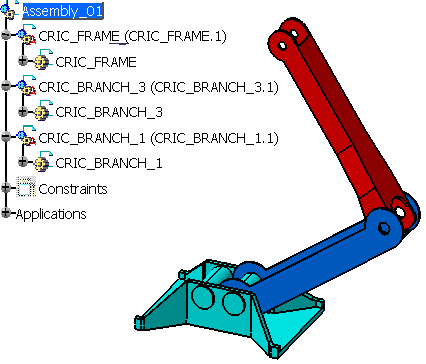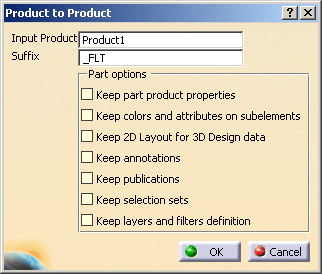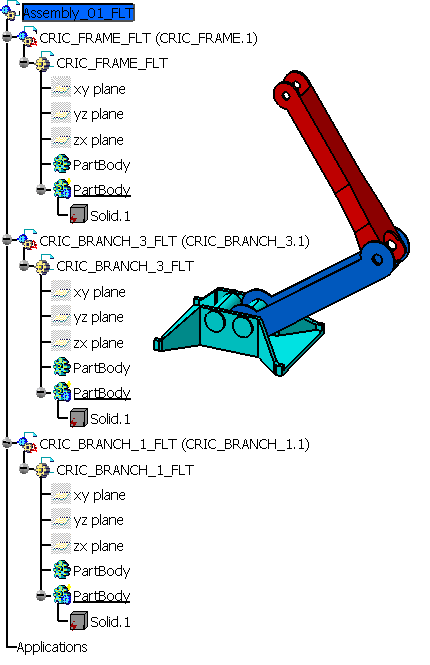| Shown geometry and component Graphic attributes Product properties on product Axis system Naming |
always kept |
| Part product properties | optional |
| Part colors and attributes on subelements | optional |
| 2D Layout for 3D Design data | optional |
| Part annotations | optional |
| Part publications | optional |
| Part selection sets | optional |
| Part layers and filter definitions | optional |
Any data other than the ones described above are removed in the newly created CATPart and CATProduct (Publications, annotations, spot weldings, etc. on the product structure are not kept).
In this task, you will find:
- a simple example,
- the description of the standard behavior.

-
Click Product to Product
 and select the node Assembly_01.
and select the node Assembly_01. -
The dialog box is displayed:

-
Click OK. A progress bar is displayed while the new CATProduct and its new CATParts are created.
It looks like this: 
Standard Behavior
For the product structure:
- The structure instance/reference is kept.
- You can select any node in the product structure: only this node and the elements it contains will be processed, enabling you to create a new CATProduct from only a portion of the initial CATProduct. The result depends only of the reference of the node you have selected. Therefore the positions of the geometries, the visibility and the colors that are transferred are those of the reference of the node you have selected (if the node you have selected is an instance, Product Data Filter ignores the overloaded properties of the instance and takes the initial properties of the reference into account).
- A CATProduct and CATParts are created:
- the default name of the CATProduct is "Name_of_Node_of_Original_CATProduct"_FLT and can be edited.
- The part numbers of the resulting CATProduct and CATParts are "Original_PartNumber"_FLT .
- If you select an instance of a CATPart, a new CATPart is created.
- The CATParts contained by the CATProduct are processed as described in Part to Part.
- A component is created in the resulting CATProduct for each component under the node that is visible in the reference of the node you have selected, that contains visible geometries,
- The components thus created keep the name of their counterparts in the original CATProduct.
- The graphic attributes of the components are kept.
For the parts:
- The geometries found in CATParts are transferred as solids, surfaces or wireframes and placed in the corresponding new CATPart.
- The solids in CATParts are created with the graphic properties (color, line type, line thickness, transparency) of their original body, the surfaces and wireframes are created with the graphic properties of their original feature.
- When a visible geometry is found in a body of the original CATPart, a body with the same name is created in the resulting CATPart.
- The layer attribute on each element of the original CATPart is always kept.
- Current filter and layer of the original CATPart are not kept in the resulting CATPart.
- The current filter is not taken into account: Product to Product considers the filter All visible is active.
Options
You can select several options to transfer some elements that are not transferred in the standard behavior. For more information, see the Part to Part chapter.
There are no options to modifiy the behavior for the product structure.
![]()